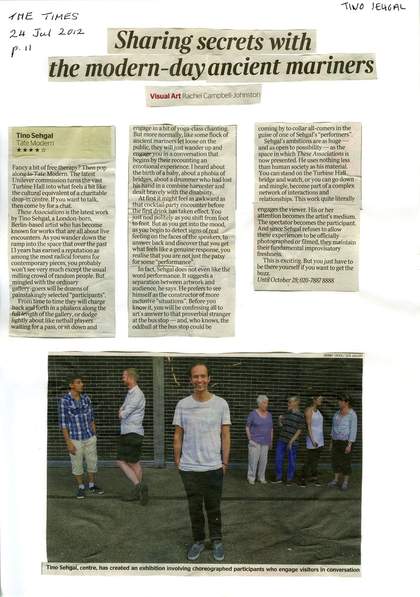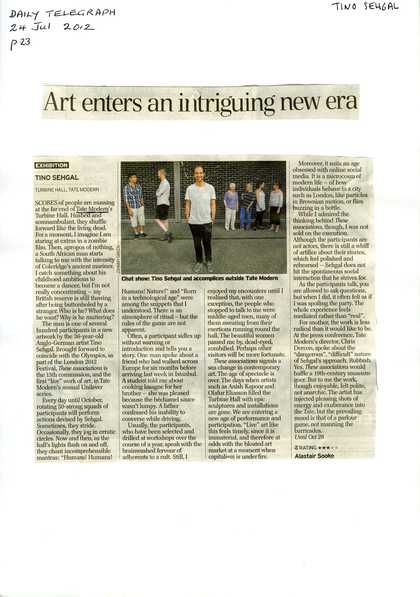Tino Sehgal’s performance piece This is propaganda 2002 is perhaps an unlikely artwork to be included in a museum collection. It is entirely immaterial, has never been captured on film or in photographs, and does not have a formal, written acquisition record. The performance itself takes place inside a gallery and consists of a set of precise actions undertaken by one employed performer dressed as an official gallery attendant. Tate conservator Pip Laurenson and Assistant Professor Vivian van Saaze have described what it is like to encounter the work as a visitor:
Whilst walking through the museum galleries the sound of a woman’s voice can be heard singing. On entering the gallery where the sound is coming from, a female gallery assistant turns and faces the wall and the singing begins again ‘This is propaganda, you know you know, This is propaganda you know’. Only when she slowly turns to face the visitor on the last ‘This is propaganda’ is it clear that she is singing and that it is live and not a recording. At the end of the refrain the title of the work and the name of the artist is spoken, along with the date of the work and when it was acquired, simulating a wall text. The visitor may ask a question, and a discussion may ensue until someone else enters the gallery and the work begins again.1
The performer or ‘interpreter’ of the work, to use Sehgal’s word, enacts the work by following precise instructions delivered either by a member of Tate staff trained by Sehgal or by one of the artist’s producers. These instructions are not written down and only exist through verbal transmission. Indeed, a standard condition of all of Sehgal’s live works is that they are not documented or recorded in any material form.

Fig.1
Rachel Campbell-Johnston, ‘Sharing Secrets with the Modern-day Ancient Mariners’, Times, 24 July 2012
Photo: Johnny Green © Tate

Fig.2
Alastair Sooke, ‘Art Enters an Intriguing New Era’, Daily Telegraph, 24 July 2012
Photo: Johnny Green © Tate
Seghal studied dance and political economics at Humboldt University in Berlin and Folkwang University of the Arts in Essen. This dual educational background animates his art practice. His works are performance-based as dance often is, yet they circulate as artworks within institutions, which are responsible for preserving them. By prohibiting any visual or material record of the work, Sehgal makes it impossible to see his performance without directly experiencing it. He has claimed that ‘substituting [the work] with some material object like a photo or video doesn’t seem like adequate documentation’.2 Not wanting his work to follow the tendency of some performance works to eventually be represented, or even substituted, by a single, material object – often a photograph – Sehgal’s limitation of this documentation process, coupled with the museum’s freedom to re-perform the work, ensure a continued liveness. Even press coverage of exhibitions and commissions by Sehgal tends to present only one or two non-performance photographs which repeat across a number of publications (figs. 1 and 2). Critics writing around Sehgal’s work repeatedly come back to the idea that ‘to experience it at all you had to be there’ and that ‘it’s now or never with Sehgal’.3
This is propaganda was first performed at the Venice Biennale as part of ‘Utopia Station’ in 2002. After its purchase by Tate in 2005 it was shown within Tate Britain’s collection galleries as part of the Tate Triennial in 2006. The work exists within an edition of four, one of which is owned by Tate. Having not bought a material artwork, and the artist insisting there be no written certificate to prove ownership, Tate can only be said to have purchased the rights to enact the performance.4 The verbal contract, legally binding but at odds with the precise record-keeping of the traditional museum, was witnessed by a notary and several members of museum staff. Notes relating to the purchase were taken, but in keeping with the lack of other visual documentation there exists no written record of the contract in its entirety.5 After the work’s purchase, Sehgal followed a model similar to that found in dance, whereby instructions are passed on from person to person, to establish a chain of staff members at Tate responsible for its continuation. The staff members responsible for recounting the work are now able to teach the selected ‘interpreters’ how to perform the instructions, creating an extended network of teaching and learning, which enables the transmission of the piece to continue – through body-to-body repetition – into the future.
The documentation limitations placed on This is propaganda mean that the work seems to disappear, or is at least rendered dormant, when not on display. The museum has the right to display the work as they would any other collection piece, after consultation with the artist, and therefore the potential for the piece to be revived remains ever present. Rather than disappearing and re-appearing, then, the piece oscillates between being dormant and being active, but it continues to exist as an ‘object’ within the museum. It exists continuously somewhere in the museum, whether in the memory of those instructed in how to teach it or in the body of an interpreter actively performing it. Consequently the work, through these remembered or embodied instructions, circulates between the memories and bodies of the curators, the performers, the producers and the viewers. Through this oscillation between presence and absence, the artwork, then, becomes a commodity which both creates and fulfils its own demand. Through the insistence of not documenting the work, alongside this appearance-disappearance-reappearance cycle, Sehgal ensures that a material object, such as a photograph, never comes to be a substitute that the museum or private collector can own. In this way Sehgal creates a work that can exist within the logic of the art market, to be bought and sold, performed and loaned out, thanks to its repeatability, but in a way which resists the continuous production of new objects that circulate independently of the central performance-based work.
In this complex system of circulation and continuity, Sehgal navigates the tension between the viewer’s desire to see the artwork and the viewer’s ability to see it. Performance scholar Sandra Umathum has called the effect of this strange ontology the ‘permanence of repetition’, suggesting how even the ‘dormant’ periods of This is propaganda can be read as its continuous unravelling. 6
Seeing the work as a process encourages a reading of each period of performance and each period of remembrance as an extension of Sehgal’s work, rather than a cyclical return to one original act. The locus of This is propaganda , and Seghal’s work more broadly, is not necessarily in the action, or even the experience of the action, but rather in the full system of that action’s production, repetition and circulation within the museum framework. By creating a work that not only confronts but also inhabits the space between ephemerality and permanence through an alternation between activation and dormancy, Sehgal has harnessed the rhythms of museum collecting and exhibition organising to ensure the life of his work. The result is a work of art that is much more complex than its simple actions first suggest.
Acatia Finbow
August 2015
